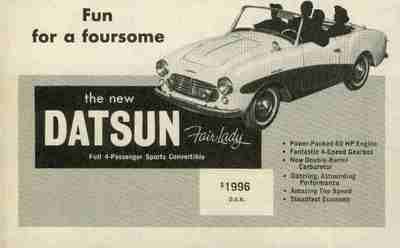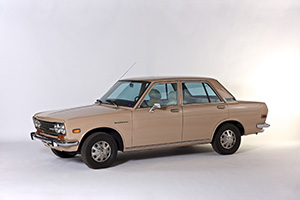11th annual Japanese Classic Car Show
Long Beach,
California
Nissan continues heritage Summer tour
NASHVILLE, Tenn. September 10, 2015; In mid-August, a pair of early Datsun sedans crashed the party at the annual Rolex Monterey Motorsports Reunion, cruising the streets of Carmel, Calif. among the multi-million dollar Ferraris, Bugattis, Duesenbergs and the like. This month, the very same 1967 Datsun 411 and 1972 Datsun 510 will be among the honored guests at a slightly more humble, but no less exciting, auto enthusiasts' gathering – the 11th annual Japanese Classic Car Show (JCCS).
The event, which will be held September 19 from 9 a.m. to 3 p.m. PDT in the Queen Mary Event Park, Long Beach, Calif., is "dedicated to Old School Japanese Cars." The mint condition 1967 Datsun 411 and 1972 Datsun 510 certainly meet that requirement. As in August, the two early Datsuns will be joined by the all-new 2016 Nissan Maxima 4-Door Sports Car, demonstrating once again the "evolution of the sports sedan."
But that's not all. Nissan will also be pulling out several other not-rarely seen vehicles: a 1967 Datsun Bluebird 2000GTX and a 1997 Nissan R390 GT1 racer, both out of Nissan's Heritage Garage in Zama, Japan, and a little/big truck combo – a 1960 Datsun 1200 Van towed by a 2016 Nissan TITAN XD pickup. The new TITAN XD, which goes on sale late this year, is making its first major event public showing in Southern California.
More than 7,000 spectators are expected to view the 400-plus classic and near-classic Japanese vehicles at the event.
"The Japanese Classic Car Show is the biggest Japanese heritage event in the country, and Nissan is proud to be both a participant and an event partner," said Pierre Loing, vice president, Product Planning, Nissan North America, Inc. "Our display vehicles perfectly express our brand heritage, as well as spanning nearly our entire 57-year history in the United States."
Nissan vehicles were first sold, under the Datsun nameplate, in 1958. The first company headquarters were located just up the 405 Freeway from where the JCCS is being held this year. Nissan North America, Inc. headquarters are now located in Franklin, Tenn.
"The interest in vintage and classic Japanese branded cars and trucks is growing every year and is moving far beyond its West Coast roots," added Loing. "While the Datsun 510 and Datsun 240Z remain the most well-known for most enthusiasts, events like the JCCS really bring out some great forgotten models like our 411 and Bluebird. And who knows, maybe someday the 2016 Maxima and TITAN XD will achieve classic status, too."
Following is a brief look at the Nissan/Datsun vehicles on display at JCCS (#Nissan4Life):
|
|
1960 Datsun VG223 Van Produced for only one year, the VG223 had the dimensions of a compact wagon. It was a rare sight in the U.S. market, with only 269 Datsun trucks imported in total, and most of those being pickups. Surfboards were not included with the purchase price. |
|
|
1967 Datsun 411 The Datsun 411 was produced from 1965 to 1967 and featured a body designed by Italy's famed Pininfarina studio. It shared its 96-horsepower 1.6-liter inline 4-cylinder engine with the sporty Datsun 1600 Roadster. |
|
|
1972 Datsun 510 First introduced in 1968, the Datsun 510 reflected a novel concept at the time: an attractive, economical, fuel-efficient, 5-passenger sedan that was fun-to-drive. The 510 was named by Road & Track magazine as "one of the most important cars of the 20th Century." |
|
|
1975 Datsun 610 Bluebird 2000GTX The 610 series was launched in 1971 and was badged as the Datsun Bluebird-U, for "User Oriented." This signified higher comfort levels than offered by its predecessor, the 510. The 610 was one of the first Nissan products to adopt a popular "coke bottle" styling appearance. |
|
|
1997 Nissan R390 GT1 The Nissan R390 GT1 had a brief two-year racing career, including Le Mans. The mid-engine design utilized a 641-horsepower 3,495cc twin-turbo V6 engine with 470 lb-ft of torque. It was timed at 3.3 seconds 0 – 60 mph and 10.9 seconds at 155 mph for the ¼-mile. Two road car versions were built with a price tag of over $1 million each. |
|
|
2016 Nissan Maxima The all-new 2016 Maxima takes the nameplate's position as the "4-Door Sports Car" to its highest execution ever. The re-engineered 3.5-liter DOHC 24-valve V6 is rated at 300 horsepower – more than three times that of the Datsun 411 and 510 engines – and 261 lb-ft torque. |
|
|
2016 Nissan TITAN XD Almost big enough to carry the 1961 Datsun Van in its bed, the all-new TITAN XD goes on sale in late 2015. It is powered by a 5.0-liter Cummins Turbo Diesel V8 rated at 310 horsepower and 555 lb-ft of torque. It can tow more than 12,000 pounds. |
So How Did Japanese Car Makers Beat The Pants Off Of The Big Three?
 |
Back then kiddies, when you bought a new car you would first need to spec out your CHOICES: which engine, tire size, rear axle ratio; you decided if you really needed a heater or an air conditioner or a radio or carpeting or two tone paint or an automatic transmission instead of the standard three speed. You and a knowledgeable salesperson, together, designed the car that you wanted to buy, agreed on a price and then ORDERED IT. Yes, that's right, you ORDERED the car. Before JIT production, computers on the assembly line, robots, and robot robots, before all this high tech stuff ever happened, back then you bought a car that was MADE FOR YOU!, and made the way that met your driving needs and pocketbook. Although it might take 6 or 8 weeks to get, it was your car.
So what happened to change this here in the U.S., two words: Japan and stupid big three management (five words actually). The Japanese took a cue from a famous American auto pioneer and built cars the way they wanted and needed to ("You can have any color as long as its black," said Mr. Ford). Toyoda, Datsun and Honda shipped little white cars over by the boatload, put them on the dealers lot, gave the buyers no choice (because they were just too far away from our market and very few buyers would or could wait 6 months for their new car) and then sold the heck out of them… and changed the way they sell and we buy cars.
The American manufacturers had an historic built-in home team advantage that they stupidly gave up, instead of marketing their cars as customized “built for the buyer”, the "smart guys" in Detroit tried to emulate the way the newcomer Japanese manufactured and marketed, even though they didn’t or shouldn't have had too, and the rest is history.
Oh I forgot to say that the Japanese built better quality cars that used less gasoline and then got lucky as the American car makers did not anticipate the gasoline shortages that occurred...once more asleep at the wheel I suppose.
About Nissan Motor Co.
Nissan Motor Co., Ltd.,
Japan's second-largest automotive company, is headquartered in Yokohama,
Japan, and is part of the Renault-Nissan Alliance. Operating with more than
247,500 employees globally, Nissan sold 5.32 million vehicles and generated
revenue of 11.38 trillion yen (USD 103.6 billion) in fiscal year 2014.
Nissan delivers a comprehensive range of more than 60 models under the Nissan, Infiniti and Datsun brands. Nissan leads the world in zero-emission mobility, dominated by sales of the LEAF, the first mass-market, pure-electric vehicle. It is the best-selling EV in history.
About Nissan North America
In North America,
Nissan's operations include automotive styling, engineering, consumer and
corporate financing, sales and marketing, distribution and manufacturing.
Nissan is dedicated to improving the environment under the Nissan Green
Program and has been recognized annually by the U.S Environmental
Protection Agency as an ENERGY STAR® Partner of the Year since 2010.










